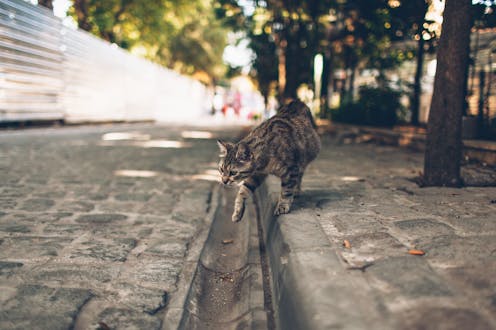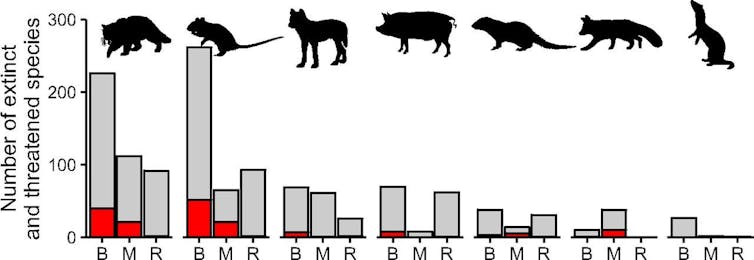To protect wildlife from free-roaming cats, a zone defense may be more effective than trying to get
A new study shows that when free-ranging cats are more than a few blocks from forested areas in cities, such as parks, they’re more likely to prey on rats than on native wildlife.

Should domestic cats be allowed to roam freely outdoors? It’s a contentious issue. Those who say yes assert that they’re defending outdoor cats and the people who care for them. Critics respond that free-roaming cats kill so many birds, reptiles, mammals and important insects like butterflies and dragonflies that they threaten biodiversity on a global scale.
As conservation biologists familiar with these clashing viewpoints, we wondered whether there was room for a more nuanced strategy than the typical yes/no standoff. In a recently published study, we used camera traps at hundreds of sites across Washington, D.C., to analyze the predatory behavior of urban free-roaming cats. The cameras recorded all cats that passed them, so our study did not distinguish between feral cats and pet cats roaming outdoors.
Our data showed that the cats were unlikely to prey on native wildlife, such as songbirds or small mammals, when they were farther than roughly 1,500 feet (500 meters) from a forested area, such as a park or wooded backyard. We also found that when cats were approximately 800 feet (250 meters) or farther from forest edges, they were more likely to prey on rats than on native wildlife.
Since the average urban domestic cat ranges over a small area – roughly 550 feet (170 meters), or one to two city blocks – the difference between a diet that consists exclusively of native species and one without any native prey can be experienced within a single cat’s range. Our findings suggest that focusing efforts on managing cat populations near forested areas may be a more effective conservation strategy than attempting to manage an entire city’s outdoor cat population.
Cats on the loose
Free-roaming cats are a common sight in Washington, D.C., which has a feline population of 200,000. Like many cities, Washington has had its share of cat management controversies.
Professionals on either side of the free-roaming cat debate largely agree that cats are safest when kept indoors. An outdoor cat’s lifespan generally peaks around 5 years, compared with 10 to 15 years for an indoor cat. Free-roaming cats face numerous threats, including vehicle collisions and contact with rat poison. Acknowledging these risks, most animal welfare organizations encourage an indoor-only lifestyle.
Similarly, there is little disagreement that cats hunt; for centuries humans have used them for rodent control. But invasive rats, which are often the target of modern rodent control, can grow too large to be easy prey for cats. In response, cats also pursue smaller species that are easier to catch. Studies have linked cats to 63 extinctions globally and estimated that cats kill 12.3 billion wild mammals annually in the U.S. alone.
Disagreements arise around handling cats that already live outside. Population management programs often utilize trap-neuter-return, or TNR – a process in which cats are trapped, spayed or neutered and re-released where they were caught.
In theory, TNR limits population growth by reducing the number of kittens that will be born. In reality it is rarely effective, since 75% of individual cats must be treated every year to reduce the population, which is often not feasible. Regardless, reproduction itself is not what most worries conservation biologists.
Feline invaders
Today the Earth is losing wild species at such a rate that many scientists believe it is experiencing its sixth mass extinction. In this context, free-roaming cats’ effects on wildlife are a serious concern. Cats have an instinctual drive to hunt, even if they are fed by humans. Many wildlife populations are already struggling to survive in a rapidly changing world. Falling prey to a non-native species doesn’t help.
Cats aren’t picky hunters but will pounce on the easiest available prey. This generalist predatory behavior contributes to their reputation as one of the most damaging invasive species. In our view, however, it could also be a key to limiting their ecological impact.

Managing cats based on their behavior
Since cats are generalist predators, their wild-caught diet tends to reflect the local species that are available. In areas with more birds than mammals, like New Zealand, birds are cats’ primary prey. Similarly, cat diets in the most developed portions of cities likely reflect the most available prey species – rats.
While cats top the list of harmful invasive species, rats aren’t far behind. In cities, rats spread disease, contaminate food and damage infrastructure. There aren’t many downsides to free-roaming cats preying on rats.
City centers have no shortage of rats, which can live anywhere, including parks, subways, sewers and buildings. But native animals tend to stay in or near areas with sufficient outdoor habitat, like parks and forested neighborhoods. When cats hunt in these same spaces, they are a threat to native wildlife. But if cats don’t share these spaces with native species, the risk declines dramatically.
Conservation funding is limited, so it’s critical to choose effective strategies. The traditional approach to cat management has largely consisted of attempting to prohibit cats from being loose altogether – an approach that’s incredibly unpopular with people who care for outdoor cats. Despite calls for outdoor cat bans, few have been enacted.
Instead, we suggest prioritizing areas where wildlife is most at risk. For example, cities could create “no cat zones” near urban habitats, which would forbid releasing trap-neuter-return cats in those areas and fine owners in those areas who let their cats roam outdoors.
In Washington, D.C., this would include forested neighborhoods like Palisades or Buena Vista, as well as homes near parks like Rock Creek. As we see it, this targeted approach would have more impact than citywide outdoor cat bans that are unpopular and difficult to enforce.
Hard-line policies have done little to reduce outdoor cat populations across the U.S. Instead, we believe a data-driven and targeted approach to cat management is a more effective way to protect wildlife.
[Understand new developments in science, health and technology, each week. Subscribe to The Conversation’s science newsletter.]
The authors do not work for, consult, own shares in or receive funding from any company or organization that would benefit from this article, and have disclosed no relevant affiliations beyond their academic appointment.
Read These Next
West Antarctica’s history of rapid melting foretells sudden shifts in continent’s ‘catastrophic’ geo
A picture of what West Antarctica looked like when its ice sheet melted in the past can offer insight…
How the ‘slayer rule’ might play a role in determining who will inherit wealth from Rob Reiner and h
These rules have a long history in the United States. They played a role in the notorious murders by…
As DOJ begins to release Epstein files, his many victims deserve more attention than the powerful me
Powerful men connected to Jeffrey Epstein are named, dissected and speculated about. The survivors,…






